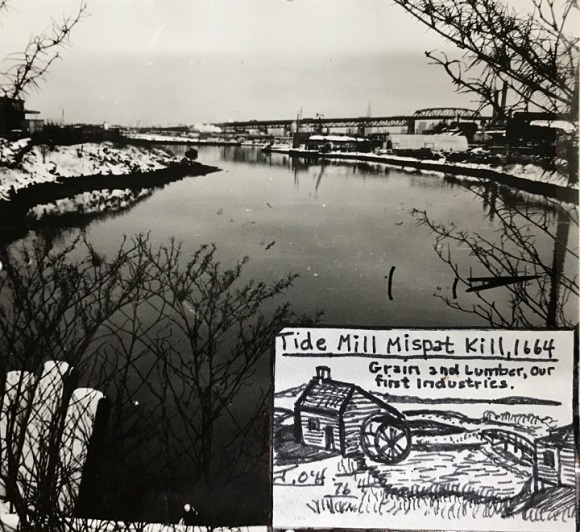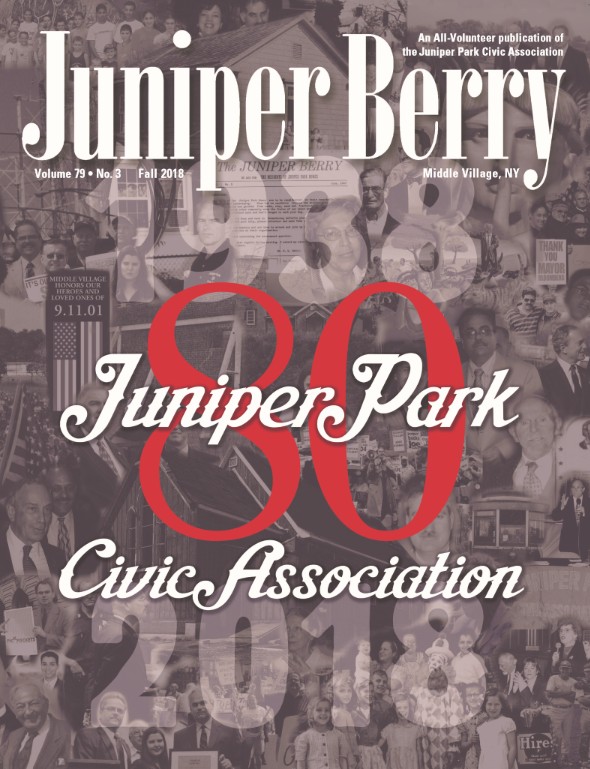The Maspeatches Indian Village site was located near the head of Maspeth Creek, on rising ground east of Mt. Zion Cemetery. Indian artifacts were found in the area by a local teen, and documented by local historian, Reverend John D. O’Halloray, who illustrated the photo inset of what the Tide Mill at Mispat Kill (creek) would have looked like in 1664. The old Kosciusko Bridge is visible in the distance to the right. It was also reported that foot long oysters were once pulled from Newtown Creek. Father O’Halloray was one of the authors of “Our Community”, and is credited with some of the information in this article.
I personally find it fascinating that we know the names of the first Europeans to settle near the Newtown and Maspeth Creeks. The first Dutch and English settlers who got land from the Dutch patent, aka the Mispat Patent, set up farms, called bouweries.
Hans Hansen aka Hans the Boore, held about 400 acres at the head of Newtown Creek. His nickname could be translated for either a term of trade, or for his disposition, so I will leave that to your imagination as well. Richard Brutnell held land farther down the creek, and Tyman Jansen, who worked for the Dutch West India Company, owned a plantation on the other side of Newtown Creek. A soldier for the Dutch West India Company by the name of Ensign Dircks held land on the Maspeth side of Newtown Creek, which became known as the English Kills. The water ways on the Bushwick side of Newtown Creek were called the Dutch Kills, something that finally made sense to me, since the Dutch and English were the ones looking to claim settlements all across the land. These folks lived in the wilderness, where the swamps were full of snakes and the woods were filled with wolves, giving the place the nickname ‘Suicides Paradise’ during the Colonial Era, as a colonist could easily loose his life, whether it be by choice, or by chance. All the main roads in our area were originally Indian Trails, and Fresh Pond Road was one of them, named for the many fresh ponds scattered along it between Maspeth, Middle Village, and into Glendale. If you follow Fresh Pond Road to the end, it ends in a little square at Cypress Hills Street, a street named for all the Cypress trees in the area. That park was once called Clamshell Park due to all the clamshells found there, left by our Rockaway Indians.
Around 1640 Dutch Governor William Kieft began granting patents of land to anyone, Dutch or English, who would agree to settle this wilderness, and a Rev. Francis Doughty, whose overzealous religious beliefs were even too much for the Pilgrims in Massachusetts, acquired close to 15,000 acres of land, nearly all of today’s Western Queens. This occurred on March 28, 1642, which became the official birth date of the town of Maspeth. It was called the Mispat (later Newtown) Patent, and he chose to settle the land near the creek so if necessary, they could escape “from Indians or wild beasts”.
Everything was going along fine, until the Indian wars broke out, known as Kieft’s Wars. Governor Kieft had his soldiers attack an Indian Village in New Jersey because he thought the Indians were responsible for some injustice against one of his land holdings, although Kieft was known to grant away their hunting grounds without compensation or permission. When the Indians realized it was the soldiers they attacked many white settlements, including those at the Maspeth Creek, – twice! Rev. Doughty escaped to Manhattan, but Hans Hansen was among those killed. Some of the settlers relocated and a new village within the Newtown Patent was formed at Queens Blvd. and Grand Ave, which would later be named Elmhurst, but for now it was called Middleburgh, and then finally Newtown Village. In the meantime, our hardy Maspeth settlers moved back in to the Maspeth Creek area for a third time. At this point the Newtown Village folks got together and realized the only way to avoid more troubles with their Native neighbors was to buy the land from them. The entire original Newtown Patent of 1642 was bought, and the new deed was dated April 12, 1656.




